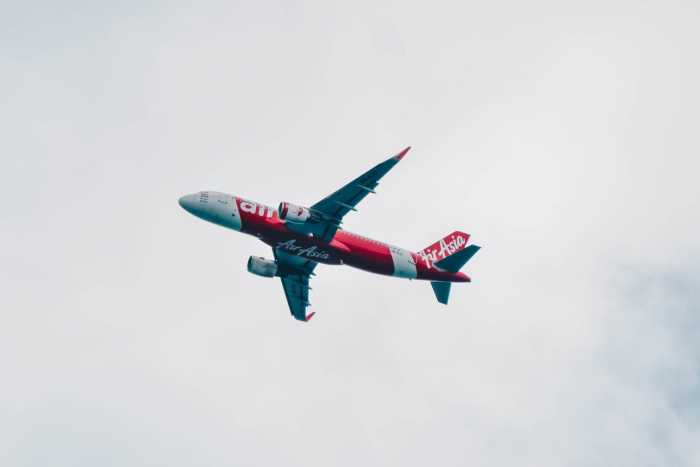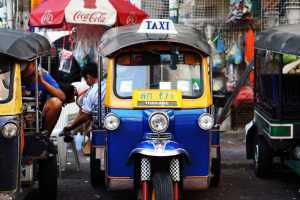
Air Aisa Set To Make Major Announcement
28th Sep 2008

Air Asia, a major low cost carrier servicing Phuket, of which the Thai company Thai Air Asia is a joint venture partner, is set to make a major announcement relating to Phuket in the third week of October.
However, the carrier, which wants to establish a base here, is being coy at this stage about giving away too many details. The announcement will be made by Air Asia CEO Tony Fernandos.
If it is more flights, or setting up a base in Phuket, then it will add to the eight daily round trips between Phuket and Bangkok and the daily roundtrip between Phuket and Singapore. Both are on Airbus A320 aircraft.
Air Asia founder Mr Fernandos, a flamboyant former record company executive who has grown Air Asia into arguably Asia's most successful budget carrier, has already confirmed to the Phuket Gazette that one of three single aisle, 164 seat [ single class, 150 seats two class ] new Airbus A320 aircraft the airline has on order will be earmarked for the Bangkok-Phuket route.
According to company sources, however, this is not what the announcement will be.
In a previous interview Mr Fernandos also indicated his great desire to set up an Air Asia base in Phuket.
Added to all of this Mr Fernandos confirmed that Air Asia has been scouting for up to three sites on Phuket for its new budget hotel, Tune.
We will have to wait to see what the announcement is in October.
In many ways establishing a base in Phuket would be appropriate. AirAsia began its regional flights from Kuala Lumpur in November 2003, to Phuket. The airline quickly extended flights to Bangkok, and later Hat Yai from KL International Airport.
He said any base on Phuket, which he confessed could be some time off given what he sees as the Thai authorities negative toward budget carriers, would be for single aisle aircraft such as the Boeing 737 or Airbus A340 rather than large, wide bodied aircraft from international routes.
Mr Fernandos, who entered partnership with former Prime Minister Thaksin Shinawatra to form Thai Air Asia, said the Thai carrier did not experience any serious impact because of the closure of Phuket, Hat Yai and Krabi airports by the People's Alliance For Democracy [PAD]
'I did not see much evidence of people going home or running away,' he said.
Maybe Thai Air Asia is more fortunate than other low cost carries [LCCs] a because of the grounding of One-Two-Go, Thailand's first LCC, and Nok Air cutting services to Phuket to two at the weekend, and then none throughout September. Nok Air promises to return to the air with a revamped schedule in October..
In the meantime Thai Air Asia and Thai Airways have reaped the benefits of One-Two-Go and Nok Air's misfortunes with higher load factors.
Thai Air Asia has 10 flights a day into Phuket, including two from Kuala Lumpur and one from Singapore. Within Thailand Thai Air Asia flies out of Suvarnabhumi Airport, Bangkok to Chiang Mai, Hat Yai, Krabi, Narathiwat, Ranong, Surat Thani, Ubon Ratchathani and Udon Thani, as well as Phuket.
In November its new long haul carrier, Air Asia X will begin flights to Pert and Melbourne in Australia.
Air Asia flies 656 flights daily on 102 routes to 57 destinations in 12 countries.
Mr Fernandos clearly sees Phuket as a prime destination. That is why one of the three new aircraft to be delivered in the next three months will be dedicated to the Phuket route.
But Mr Fernandos, who is famously outspoken, has harsh words for the Airports Authority of Thailand, which runs six airports in Thailand, including Phuket International Airport.
He does not directly criticize the authorities who run PIA, but he does say that Thailand is definitely falling behind other prime tourist destinations because of the AOT's reluctance to reduce amongst the highest landing charges in Asia.
'We have delivered for them (AOT). We are the only airline to remain and not cut flights. In fact we have added capacity into Phuket.' He called the AOT 'rudderless'.
As a result of high landing charges, not to mention the ongoing political strife afflicting Thailand, Mr Fernandos said other countries like China, Indonesia, Malaysia and Vietnam and Singapore are attracting tourists that Thailand would normally get.
'Thailand thinks it does not have to do anything to attract tourists, but these other countries are increasingly attractive,' Mr Fernandos said.
Obviously a strong advocate of the LCC model that has made his name as a pioneering, gung ho Asian Richard Branson (flambouyant owner of Virgin) Mr Fernandos does not see much consolidation of LCCs in Asia, unlike Europe and the United States where consolidation of large airlines is gathering pace.
' There are not many low cost carriers left in Asia. We don't see any other carriers of interest to us. The Tiger Airways (out of Singapore) and Jetstars (out of Australia) are culturally different. Maybe there will be some consolidation in India.'
He is right. Asia was slower to catch on to the LCC model than Europe, but then there was a spurt of growth with some of the airlines being under capitalized. The LCC model is also more susceptible to higher fuel prices than full service carriers because of their leaner operating procedures and they are less likely to hedge their fuel ahead as much as the legacy carriers (which full service carriers are called).
Certainly the LCC model is here to stay in world aviation. The latest statistics from an Air Transport News annual top airlines survey for 2008 shows three LCCS grouped at numbers 24, 25 and 26 (Ryanair, Ireland; Air Berlin, Germany and JetBlue, US) with easy-Jet (UK) at number 30. This is a remarkable showing by the LCCs considering they operate mainly smaller, single aisle aircraft like the Boeing 737 or Airbus A320 and only fly directly from point to point and not through airport hubs where full service carriers flying twin aisle aircraft can pick up many more transit passengers than an LCC.
The interesting statistic, however, is in the load factors. Because of their lower fare structures, higher frequency of flights and quick turnaround on which the LCC model is based, LCCs carry a proportionally higher number of passengers than full service carriers. For example in the Air Transport News survey easyJet is number three, Ryanair No 8, Virgin Blue [Australia] number No 13 and JetBlue No 19 out of the top 20.
However the LCCs in Asia are still very vulnerable when it comes to fuel. The survey shows that Asia Pacific had a 126.4 percent increase in the cost of jetfuel in the last three years, second only to the Middle East and Africa. The global average was a 122.8 percent increase.
However, all this does not seem to have stopped Air Asia's expansion. Since it introduced its low fare, no frills concept in December 2001, the airline now flies to over 60 destinations in Malaysia, Thailand, Indonesia, Singapore, China, Philippines, Brunei, Cambodia, Laos, Vietnam and Myanmar, formed two successful joint ventures in Thailand through Thai AirAsia, and Indonesia through Indonesia AirAsia, expanded its fleet from the original two to 28. To date the AirAsia group, has carried over 35 million guests.
Flights to Indonesia commenced in April 2004 with routes serving Bandung, Surabaya, and Jakarta from KL International Airport. Subsequently the airline also introduced flights to Bali, Medan and Padang.
In Jan 2004, AirAsia formed a partnership with Shin Corporation in Thailand to develop the low fare carrier Thai Air Asia. Shin Corporation held 50% stake, AirAsia 49% and the remaining 1% by an individual. With two planes based in its Bangkok, Thai AirAsia launched domestic operations in Thailand on January 13, 2004 with daily point-to-point flights from its new Bangkok hub and has since expanded to more domestic routes and new international flights to Singapore.
AirAsia has secured a 175 aircraft commitment with Airbus for A320 aircraft. The 175 aircraft order will place AirAsia as the single largest customer for the aircraft in Asia-Pacific, and potentially one of the largest airline fleets in the region. The new aircraft would gradually replaced AirAsia's existing Boeing 737-300s.
On 23 of March 2006, AirAsia moved its operations to the new Low Cost Carrier Terminal (LCCT). This is a major milestone as it is the first dedicated terminal for low cost carrier operations in the world. The LCCT is designed to cater for 10 million passengers per annum with 30 parking bays for aircraft. It is upgradeable to cater for 15 million passengers if required.









